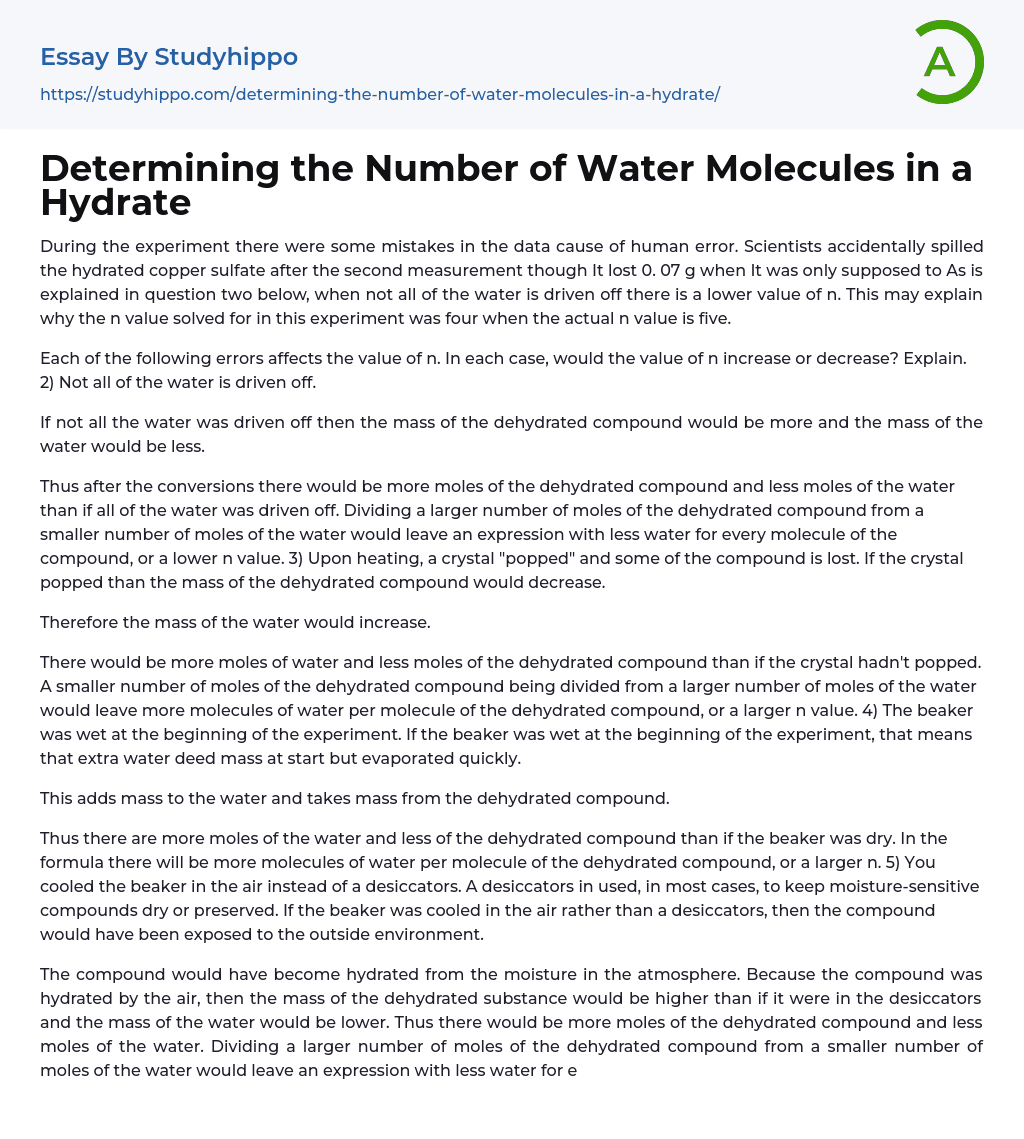

Determining the Number of Water Molecules in a Hydrate Essay Example
During the experiment there were some mistakes in the data cause of human error. Scientists accidentally spilled the hydrated copper sulfate after the second measurement though It lost 0. 07 g when It was only supposed to As is explained in question two below, when not all of the water is driven off there is a lower value of n. This may explain why the n value solved for in this experiment was four when the actual n value is five.
Each of the following errors affects the value of n. In each case, would the value of n increase or decrease? Explain. 2) Not all of the water is driven off.
If not all the water was driven off then the mass of the dehydrated compound would be more and the mass of the water would be less.
> Thus after the conversions there would be more moles of the dehydrated compound and less moles of the water than if all of the water was driven off. Dividing a larger number of moles of the dehydrated compound from a smaller number of moles of the water would leave an expression with less water for every molecule of the compound, or a lower n value. 3) Upon heating, a crystal "popped" and some of the compound is lost. If the crystal popped than the mass of the dehydrated compound would decrease.
Therefore the mass of the water would increase.
There would be more moles of water and less moles of the dehydrated compound than if the crystal hadn't popped. A smaller number of moles of the dehydrated compound being divided from a larger number o
moles of the water would leave more molecules of water per molecule of the dehydrated compound, or a larger n value. 4) The beaker was wet at the beginning of the experiment. If the beaker was wet at the beginning of the experiment, that means that extra water deed mass at start but evaporated quickly.
This adds mass to the water and takes mass from the dehydrated compound.
Thus there are more moles of the water and less of the dehydrated compound than if the beaker was dry. In the formula there will be more molecules of water per molecule of the dehydrated compound, or a larger n. 5) You cooled the beaker in the air instead of a desiccators. A desiccators in used, in most cases, to keep moisture-sensitive compounds dry or preserved. If the beaker was cooled in the air rather than a desiccators, then the compound would have been exposed to the outside environment.
The compound would have become hydrated from the moisture in the atmosphere. Because the compound was hydrated by the air, then the mass of the dehydrated substance would be higher than if it were in the desiccators and the mass of the water would be lower. Thus there would be more moles of the dehydrated compound and less moles of the water. Dividing a larger number of moles of the dehydrated compound from a smaller number of moles of the water would leave an expression with less water for every molecule of the compound, or a lower n value.
- Organic Chemistry essays
- Acid essays
- Calcium essays
- Chemical Bond essays
- Chemical Reaction essays
- Chromatography essays
- Ethanol essays
- Hydrogen essays
- Periodic Table essays
- Titration essays
- Chemical reactions essays
- Osmosis essays
- Carbohydrate essays
- Carbon essays
- Ph essays
- Diffusion essays
- Copper essays
- Salt essays
- Concentration essays
- Sodium essays
- Distillation essays
- Amylase essays
- Magnesium essays
- Acid Rain essays
- Bottled Water essays
- Agriculture essays
- Albert einstein essays
- Animals essays
- Archaeology essays
- Bear essays
- Biology essays
- Birds essays
- Butterfly essays
- Cat essays
- Charles Darwin essays
- Chemistry essays
- Dinosaur essays
- Discovery essays
- Dolphin essays
- Elephant essays
- Eli Whitney essays
- Environmental Science essays
- Evolution essays
- Fish essays
- Genetics essays
- Horse essays
- Human Evolution essays
- Isaac Newton essays
- Journal essays
- Linguistics essays



